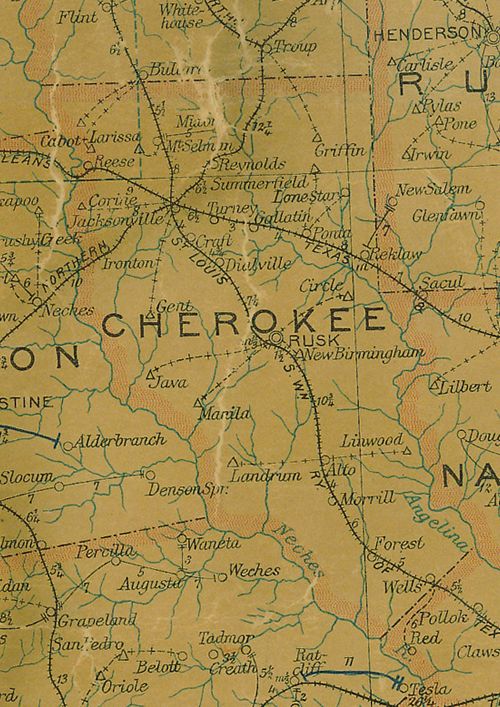|
New
Birmingham, in Cherokee
County, was supposed to be the third industrial metropolis to
bear that name. The two other Birminghams, one in England and one
in Alabama, had shown how the availability of iron ore could build
a city where not even a town had been before.
The dreamer in the case of New Birmingham, Texas, was Alexander B.
Blevins, a sewing-machine salesman who knew what had happened in the
northern part of his native state of Alabama when northern industrialists
invested capital to develop the iron industry there.
In the 1880s Blevins discovered that iron ore was abundant in Cherokee
County and was already mined to supply a foundry at the Rusk Penitentiary.
So he dreamed a big dream: a "New" Birmingham, perhaps even larger
than the one in Alabama.
Blevins organized the Cherokee Land and Iron Company with the assistance
of capitalists W.H.
Hammons, James A. Mahoney, and Robert Van Wych. They leased 20,000
acres and began mining even while they built a fifty-ton furnace that
Blevins named the Tassie Belle after his wife.
New Birmingham was laid out near the Kansas and Gulf Short Line
Railroad. In addition to the furnace, the town soon claimed 2,000
residents who enjoyed the services of a bank, saloons, a newspaper,
even the five-story Southern Hotel. Industries included a sash and
door factory, a wagon and plow works, an iron pipe factory, and an
electric generating plant. New Birmingham, "The Iron Queen of the
Southwest," seemed well on its way to prosperity and permanence. |
It was not to
be. The dreamers had attempted too much too soon, and when the Panic
of 1893 deprived them of new capital necessary to continuing developing
until profits sufficient to sustain the furnace were earned, they
were hard pressed to continue.
An attempt to involve English capitalists in the venture fell through
because of Texas' Alien Land Law, and in 1890 Hammons
was killed by a New Birmingham businessman. Then a fire destroyed
the furnace, forcing the lay off of over 300 workers.
People moved away, businesses closed, and by 1896 only 200 residents,
barely ten percent of the population less than five years before,
remained. The post office closed in 1906.
Most of the buildings in New Birmingham were scavenged during the
First World War
to provide materials for construction in Rusk,
and the hotel, the last building left standing, was destroyed by fire
in 1926. Even the rubble of the old hotel was removed in 1932 during
the construction of a highway.
The Birmingham in Alabama developed into the largest city in that
state while the Birmingham in Texas
disappeared, remembered now because of a historical marker. Even so,
it reminds us that once there was a dream. |
 |
|
Cherokee
County 1907 postal map showing New Burmingham
1 1/2
miles SE of Rusk
From
Texas state map #2090
Courtesy
Texas General Land Office
|
All
Things Historical 16-22,
2001 column
Published by permission.
Archie P. McDonald is Director of the East Texas Historical Association
and author or editor of over 20 books on Texas
|
| Texas
Escapes, in its purpose to preserve historic, endangered and vanishing
Texas, asks that anyone wishing to share their local history, stories,
landmarks and vintage/historic photos, please contact
us. |
|
|
